|
Last Sunday, the Faith Formation classes learned about the Wedding Feast at Cana, where Jesus performed his first miracle by turning water into wine. We talked about how Jesus could transform ordinary things into extraordinary ones and how Mary not only noticed the lack of wine but also proactively instructed the servants to do whatever Jesus told them. As an activity, students used fresh flowers to create individual bouquets to give to a special caregiver in their lives.
0 Comments
Last week, the younger Faith Formation students discussed creation, specifically highlighting the beauty and intricacy of butterflies as an example of God's handiwork. The students explored the concept of new life in Christ, paralleling the transformation of a caterpillar into a butterfly with spiritual renewal and rebirth. After observing live caterpillars and discussing their lifecycle from a tiny egg to a butterfly, the class went outside to enjoy the warm, sunny day. The beauty of spring helped inspire their colorful butterfly art. “Is it possible that God made butterflies to teach us lessons about life? We are all a work in progress and we have to go through a caterpillar stage before we can be transformed into a beautiful butterfly. The caterpillar might not look like much now, but when God gets done with it, it will become a creature of amazing beauty.” The older students explored the Parable of the True Vine and visited the garden to see the grape vines we planted last year which are just beginning to emerge from their winter dormancy. We also spent time cleaning and preparing the beds and garden boxes for spring planting in a few weeks. We noted that the difference between the branch and the vine is difficult to discern. What a joy it is to ponder the beauty of the plant that is made of interconnected branches, filled with the sap that flows through the vine bringing life to every part of each branch. It is by remaining on the vine that the branches bear beautiful fruit, fruit that brings glory to the vine grower, God the Father. It’s such a gift to be a branch on this True Vine! 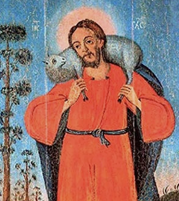 The Faith Formation students celebrated Good Shepherd Sunday by listening to the Parable of the Found Sheep, reflecting on the Good Shepherd's determination to find the one lost sheep and the joyous celebration upon its return, reminding us of Jesus' unconditional and never-ending love. The children were encouraged to think about the names of the sheep, the feelings of the lost sheep, and the Good Shepherd’s joy upon finding it. They also pondered the significance of the sheep being individually known and cared for by the Good Shepherd, like Jesus' relationship with each of us. The older students participated in a lesson focusing on Creation Care, as part of the "Season of Creation'' series. The focus was on understanding our role as stewards of the environment, emphasizing the theological and ecological significance of caring for creation. We were delighted to welcome guest speaker, Laura Everhart, a member of the Calvary Creation Care team, who shared practical stewardship strategies like recycling and composting. Students engaged in a thoughtful discussion about ways they can help care for creation both globally as well as right here in our neighborhood. We also had a chance to take a quick look at the raised bed gardens to assess readiness for planting. As an additional enrichment activity, students took a close-up look at various wonders of nature under the microscope, marveling at the intricacies and beauty of God’s creation, even on the smallest scale. The day concluded with a brainstorming session on ways the youth of Calvary can be part of the Calvary Creation Care initiatives and ideas for future collaboration within our community. Thank you, Laura and the Creation Care team for sharing a hopeful vision of the future and inspiring us all to do our part! Last week, Miss Elsa’s class discussed prayer as the way we communicate with God. The lesson included a review of formal prayers, such as the Our Father, as well other forms such as art, movement, and music. As a hands-on activity, students enjoyed creating colorful “prayer paintings”, learning that we can talk to God in many different ways! The older students explored the significance of the Last Supper, discussing how Jesus is viewed as the sacrificial lamb, akin to the lamb in Passover, and the importance of this symbolism in the context of Holy Communion. The class then visited the Lady Chapel to view the altar and the items used during Holy Communion, discussing the roles of the deacon and priest, and the Episcopal belief in the presence of Christ in the Eucharist. The lesson concluded with an interactive activity where students handled model items used in the Liturgy of the Eucharist, such as the chalice and paten, helping them understand their use and significance in the liturgy. This educational experience helped deepen their understanding of their faith and the communal aspects of participating in Holy Communion. "For the bread of God is the bread that comes down from heaven and gives life to the world.” — John 6:33
We continue our celebration of Easter! Miss Elsa’s class learned about the sacrament of baptism and discussed the significance of water, the Word, and the oils, each with deep spiritual significance. A visit to the church's baptismal font and a close-up look at the Paschal candle burning brightly further enriched their experience, making the sacrament's symbols more tangible and meaningful. As a special way to end the class, guest author, Sara Woodside, read her recently published children’s book aloud to a captive audience. Thank you, Sara! The older students reviewed highlights of the Paschal Triduum and watched portions of the video-recorded services of Holy Thursday and the Easter Vigil. Witnessing the darkness after the stripping of the altar contrasted with the candlelit procession, and the lighting of the Paschal candle during the Easter Vigil was impactful and led to insightful discussions about Christ's resurrection and victory over death and darkness. The class also took a short walk into the church for a close look at the baptismal font and the Paschal candle, then stopped momentarily in the All Saints’ chapel where students lit individual candles and said a prayer. This was followed by a brief candle-pouring demonstration in the refectory along with a discussion about the use of beeswax and the tradition of candle-making at Calvary. The morning concluded with an engaging presentation about acolytes, with a special focus on the role of the torch bearer, offering students a hands-on understanding of various opportunities to serve in our church services. The celebration of Christ's triumphant Resurrection isn't confined to just one day; the Easter season spans 50 days--rejoice and be glad!
Thank you to everyone who participated in and helped with the annual Calvary Easter Egg Hunt--a joyful and fun-filled way to celebrate the Risen Christ--Alleluia! Last week, the Faith Formation students prepared for the celebration of the Risen Christ. Miss Elsa's class discussed The Last Supper within the broader theme of the Paschal Mystery. The lesson focused on the pivotal moment when Jesus instituted the Eucharist during his last Passover meal with his disciples, emphasizing the significance of the new covenant. The presentation helped deepen the understanding of the Eucharist as a memorial of Christ's death and resurrection, preparing them for a more profound participation in the Easter celebrations. The lesson also included a taste of bread and grape juice, fostering a continued discussion of what it might have been like to eat this meal with Jesus in the Upper Room. The older students had a busy morning which included baking a large batch of “resurrection rolls” and then sharing them with the younger group along with a beautifully presented overview of Holy Week. It was truly inspiring to see the older students take on the role of mentors, sharing the profound events of the last days of Jesus with such care and reverence. Afterward, the sweet cinnamon resurrection rolls were enjoyed by all. Children’s Liturgy of the Word on Palm Sunday was especially exciting. After hearing the story of Easter read aloud, the group engaged in a reflective discussion about the events leading up to the death and resurrection of Christ. A model of the City of Jerusalem helped reinforce the historical aspects of the Triduum and seeing the recently sprouted seeds planted during last week’s class served inspired a deep sense of awe. Just as a seed must be buried in the ground before it can break through the soil in a burst of growth, Christ's resurrection signifies the triumph of life over death, light over darkness. Alleluia! The Faith Formation classes concluded their work with the Kingdom Parables, focusing on the Mustard Seed. Students were amazed to see tiny mustard seeds from Israel, just like the one Jesus referred to when teaching about what the Kingdom of Heaven is like. Some reflections included, God's great strength and power within the seed makes the tiny seed grow and change into something much bigger and so very different - a tree. There are so very many seeds in the world, seeds of all kinds, and each of those seeds has this same great strength of God working within it to cause such growth and change. How much of this strength, this energy, is at work in the world all around us! We are like the mustard seed. We began life so very tiny, and yet we are growing and changing. This strength of the life of God that is in the mustard seeds is also at work within us, causing us to keep growing and changing until and beyond our death. Afterward, the students took a close look at various garden seeds, selecting some to plant and sprout for later use in our summer garden. With the remaining time, we couldn’t forget to mention Saint Patrick and some of the many ways he helped share God’s message of love including his creative use of the shamrock to explain the mystery of the Holy Trinity.
Last Sunday, the Faith Formation classes continued their exploration of the Kingdom Parables, focusing on the Pearl of Great Price. Students had the opportunity to look closely at the various shapes and qualities of a small sample of cultured pearls and then reflected on what the Kingdom of God might be like as illustrated by the merchant's actions in the parable.
Stringing beads to make a bracelet and creating a “Pearl in a shell” craft served as a creative and tangible reminder of the lesson's core messages about value, beauty, and the joy of discovery in relation to the Kingdom of God.
"He told them another parable. “The kingdom of heaven is like leaven that a woman took and hid in three measures of flour, till it was all leavened.” ~Matthew 13:31 Last Sunday, the Faith Formation classes discussed the Parable of the Leaven and observed the effects of yeast on flour. This visual and tactile experiment allowed them to witness firsthand the growth and transformation caused by the leaven. After observing the changes in the mixture, including its increased size, smell, and texture, students discussed the implications of the parable, drawing parallels between the yeast's work and the silent, powerful workings of God's Kingdom. The mystery of the Kingdom of God is one of the greatest mysteries of our faith. It was such an important part of what Jesus wanted to communicate during His time on earth that there are over forty parables about the Kingdom in the Gospels How might we answer the question, “What is the Kingdom of God?” • What brings growth and transformation in our lives? • What is most precious to us? • In what way are we part of the Kingdom of God? • How is the Kingdom part of us? • How might the Holy Bible and the Sacraments, particularly the Eucharist, help us to ponder the Kingdom of God? The older group baked a batch of small loaves, taking turns measuring, stirring, and kneading. Everyone enjoyed eating the freshly baked bread on the playground, reveling in the warm sunshine. Spring is on its way! Last week, Miss Elsa's class focused on "Making Space" as a way of understanding Lent as a period of growth, change, and preparation for Easter. As an activity, students worked with clay to create Lenten Prayer Pots for placing notes or items that will remind them of things they want to make space for in their lives. 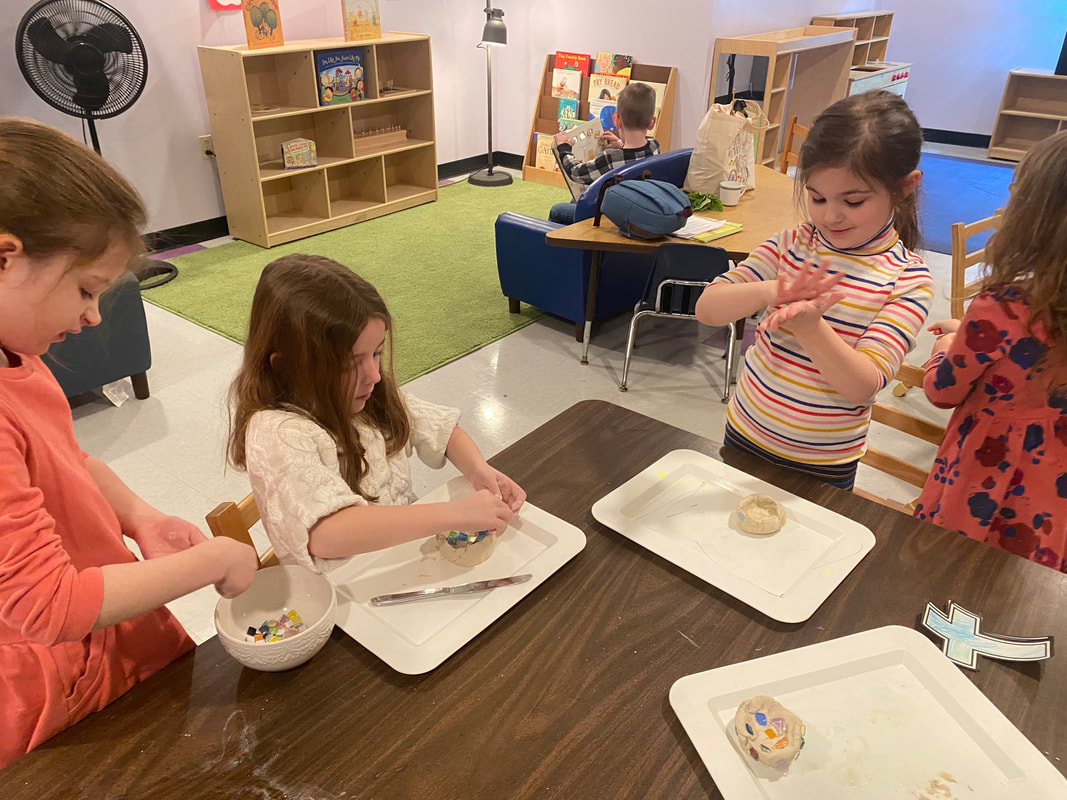 The older students learned about the daily Examen—a prayerful way to review the day to recognize God's presence and movement in our everyday lives. After the discussion, they crafted clay prayer pots, which they filled with glass stones representing different aspects of the Examen to aid in their daily reflection. Last week, our Faith Formation classes reflected on the importance of Lent, inspired by Jesus' forty-day retreat in the wilderness before starting his public work. We explored Lent as a time to make space for self-reflection, readiness, and change. The conversations shifted from seeing Lent as merely a time of giving up things to viewing it as an opportunity to deepen our understanding of God's love, which in turn, fosters personal development and change. As an activity, Miss Elsa’s class decorated small wooden flower shapes to be included in the Calvary Capital Campaign goal-tracking project. The students enjoyed adding color and creative designs to each flower which will be added to the poster as a way to track the number of pledges. The Level III students were delighted to present the final project during Coffee Hour. It was inspiring to see them articulate the design process and the significance of the artwork. Kudos to these students for a job well done! Miss Laura's Level IV class has been progressing through the Bible and is currently studying the epistles. They plan to spend one more Sunday on this subject before proceeding to explore The Revelation of John. Following this, the class will transition into a brief overview of church history, enriching their understanding of the Christian faith's development over time.
Our Faith Formation class at Calvary embarked on a creative mission to visually capture the essence of our church’s Capital Campaign. With a monumental goal of raising $6 million to Preserve, Sustain, and Share, we wanted our chart to be more than just numbers; we wanted it to be a vibrant testament to faith and God’s creation. So, with colorful markers and big sheets of paper spread out, we began brainstorming how to bring this vision to life. The idea blossomed like the very sunflowers we plant each spring in our garden. We decided to draw a tall, flourishing tree with a large, radiant sun at its center, mirroring the sunflowers that reach toward the sky in our garden. These sunflowers are special to us; they start as tiny seeds but grow into something magnificent and bountiful, a miracle we witness year after year. This growth from a small beginning to something grand became the perfect symbol for our campaign's journey. At the heart of our tree, we placed the sun, not just any sun, but one that embodies the warmth and brightness of God’s love. This sun also holds a deeper meaning for us—it reminds us of the Body of Christ that we celebrate during the Eucharist. Just as the sunflowers turn towards the sun, we are drawn to the light of Christ, nurturing our faith and community. Around the tree, we added flowers, bees, and birds, and even a life-giving river winding its way through the landscape. These elements represent the interconnectedness of all life in God’s creation. Each creature, each plant, relies on the others, just as we depend on one another in our faith community. Fluttering among the branches, a butterfly catches the eye. To us, it’s a powerful symbol of Christ’s resurrection and our own hope for renewal. This theme of renewal is echoed in the very structure of our chart. Within the tree, we carefully outlined the shape of Calvary church, signifying the ongoing growth and blossoming of our faith and community under God’s nurturing care. As for tracking our progress towards the $6 million goal, we chose to use lights—each one representing a step closer to our target. These lights are not just markers; they symbolize bringing more of God’s light into our church and community, both literally and figuratively. Creating this chart was more than an art project for us. It was a way to express our faith, our hopes, and our commitment to the campaign. We see it not just as a tracker of funds, but as a living representation of our journey together, growing in God’s love and light, just like the sunflowers in our garden. Through this chart, we hope to inspire our church community to see the beauty and potential in each contribution, no matter how small, toward achieving something truly glorious. Last Sunday, the students in Miss Elsa’s class enjoyed an early celebration of Saint Valentine’s Day. They reflected on God’s love as a gift we can share then created special cards and candy treats to give our neighbors at the East End Cooperative Ministry. The older students learned about the Transfiguration and how Jesus' status as Messiah was confirmed by the divine testimony that he is God's beloved son. The lesson also included a brief discussion about the coming of Lent, including the meaning of Shrove Tuesday and Ash Wednesday. As we anticipate the start of Lent, our Faith Formation classes eagerly await a season filled with reflection, spiritual growth, and meaningful connections with each other and our faith. Last week, Miss Elsa’s class focused on Matthew 5:13-2 which calls us all to accept the light we have received and let it shine forth. Children reflected on how, like salt, we each add our own special flavor that makes the world a better place. The class enjoyed a hands-on activity that included crafting colorful votives which, when illuminated by flameless tealight candles, created a scintillating reminder of God’s light in each of us. The older group discussed the Gospel reading, noting Jesus went off to pray as a way of feeding his soul and listening to God. The students reviewed the Lord’s Prayer and examined various versions and translations, including one written in Aramaic. The class reflected on how both formal and informal prayer can be helpful depending on the situation. Coloring and laminating a copy of Our Father gave each student something to keep at home as a reminder of this very special way of connecting to God.
Source: https://cofewinchester.contentfiles.net/media/assets/file/Versions_of_The_Lords_Prayer.pdf Last Sunday, the Faith Formation classes discussed the Presentation in the Temple and learned how Jesus and his family followed the Jewish customs of the time – consecration to God and purification. Students reflected on how Simeon and Anna recognized Jesus as the fulfillment of the Messianic prophecies and how their openness to God’s plan offers a model for all who desire the fullness of God’s life. The younger students had a great time crafting clay sculptures to commemorate the two turtles that Mary and Joseph offered as a sacrifice. The aquaponics system set up by our Faith Formation classes in the fall has truly flourished! The sight of the vibrant fish swimming gracefully amidst the flourishing greenery brings a unique sense of warmth and hope during these chilly winter days, reminding us of the beauty and resilience of life even in the most challenging of seasons.
Last Sunday, Miss Elsa’s class reflected on the Gospel reading and learned about how Jesus invited his friends to follow him. They discussed the ways that each of us is called to follow in God’s way of love and pondered what the disciples must have thought when Jesus told them to put down their nets. The students enjoyed making colorful tin foil fish to display in the classroom and to connect with the idea of being "fishers of men’. The older students welcomed Ms. Mary Lou Southwood as special guest speaker and learned about the ongoing Capital Campaign. Mary Lou gave an informative and inspiring overview of the importance of this effort and challenged students to contribute by helping to create a visual aide to reflect the campaign’s progress. The students were excited and immediately began brainstorming creative ideas of how they can contribute to preserving, sustaining and sharing the blessing that is Calvary Church. Thank you, Mary Lou! Last Sunday, Miss Elsa’s class discussed the significance of Jesus' baptism and its connection to the theme of light. They explored the idea that Jesus is the "Light of the World." To reinforce this concept, the students used sheets of beeswax to create candles, emphasizing the symbolism of light and how it represents Jesus as the source of illumination and guidance in their lives. Because in the mystery of the Word made flesh, you have caused a new light to shine in our hearts, to give the knowledge of your glory in the face of your Son Jesus Christ our Lord. (Book of Common Prayer, page 378) The older students had a great time in the kitchen preparing soup for the upcoming Soup Group fundraiser. While working, we discussed the legacy of Dr. Martin Luther King Jr. and his emphasis on serving others as a fundamental way to express one's love for God and each other. Thank you, Miss Adele, for leading this lesson! Last Sunday, Miss Elsa’s class discussed the Adoration of the Magi. The students learned about the Magi's three gifts: gold, frankincense, and myrrh. Gold symbolizes Jesus's kingship, frankincense represents His deity, and myrrh signified His humanity. Real representations of each of the gifts were displayed for the children to touch and observe, deepening their connection to the story. The class pondered the Magi's delight at the sight of the star and their motives for bringing these precious gifts to Jesus. They also wondered how Mary felt receiving such gifts for her child and what she understood about their significance, and then shared their thoughts about the question, "What gift would you bring to Jesus?" As an activity, students enjoyed decorating wooden stars and creating their own “gifts'' from modeling clay. The older group also discussed the Adoration of the Magi and the significance of the gifts, then had a chance to see and smell the resin form of frankincense. They also helped create Epiphany Blessing Kits complete with chalk to take home--a great way to start the new year! The celebration has just begun! The Christmas season lasts twelve days, from the vigil of Christmas Eve until Jan. 5, the day before the Epiphany, also known as Twelfth Night. Instead of packing away the Christmas decorations, take some time to savor the wonder of the Incarnation and celebrate! Here are some ideas for celebrating all of Christmastide with your family:
|
Location |
|
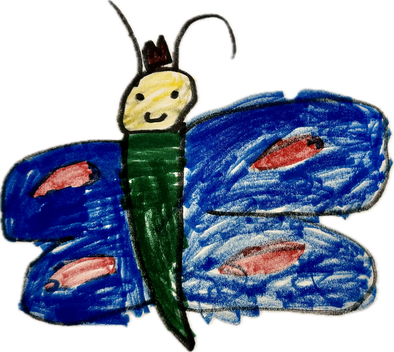
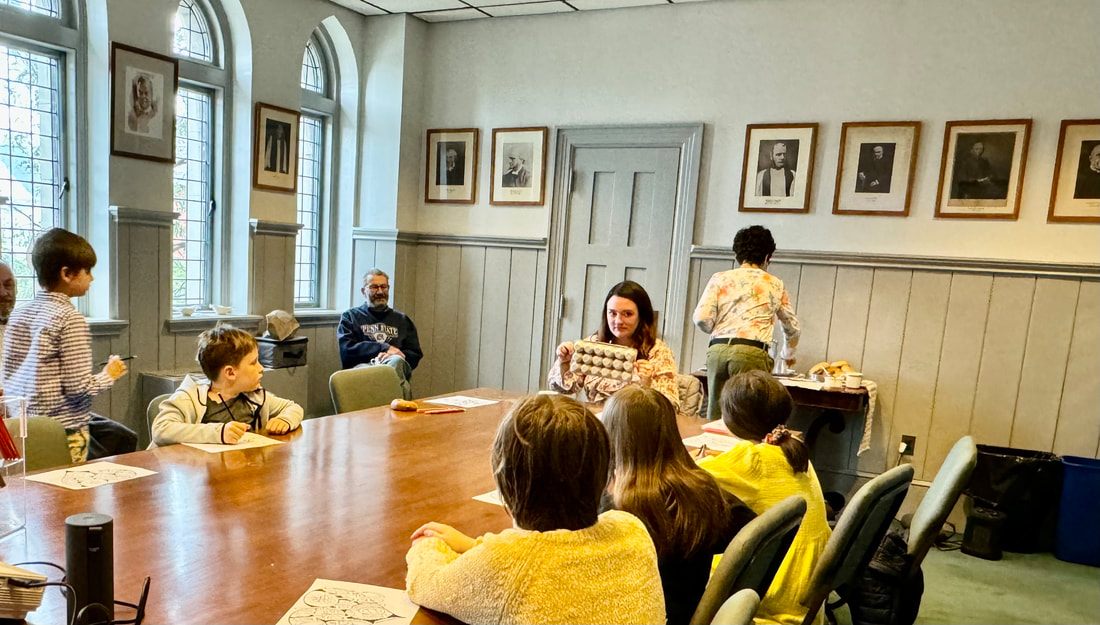
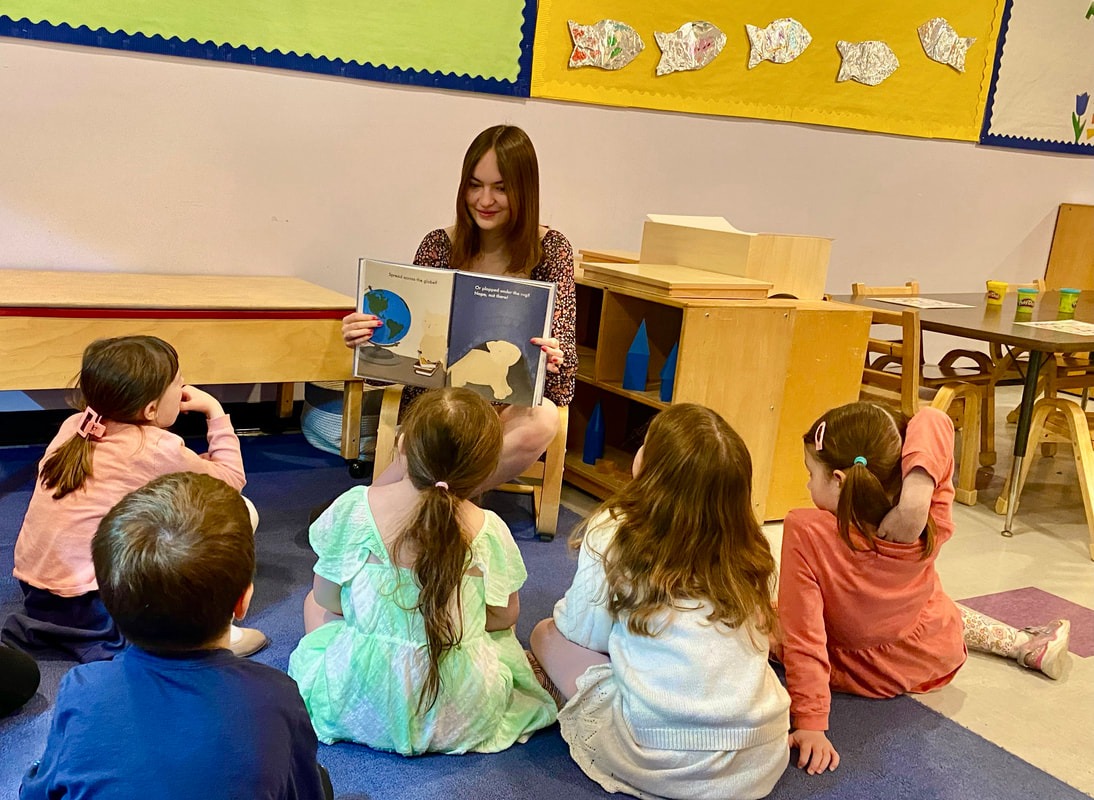
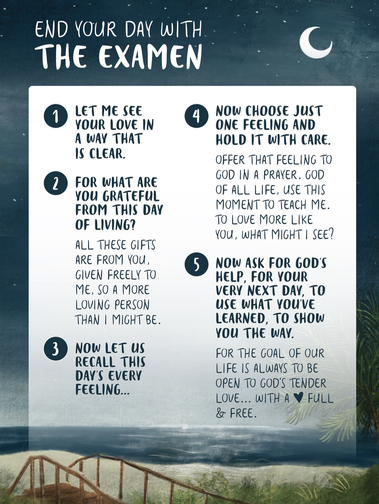
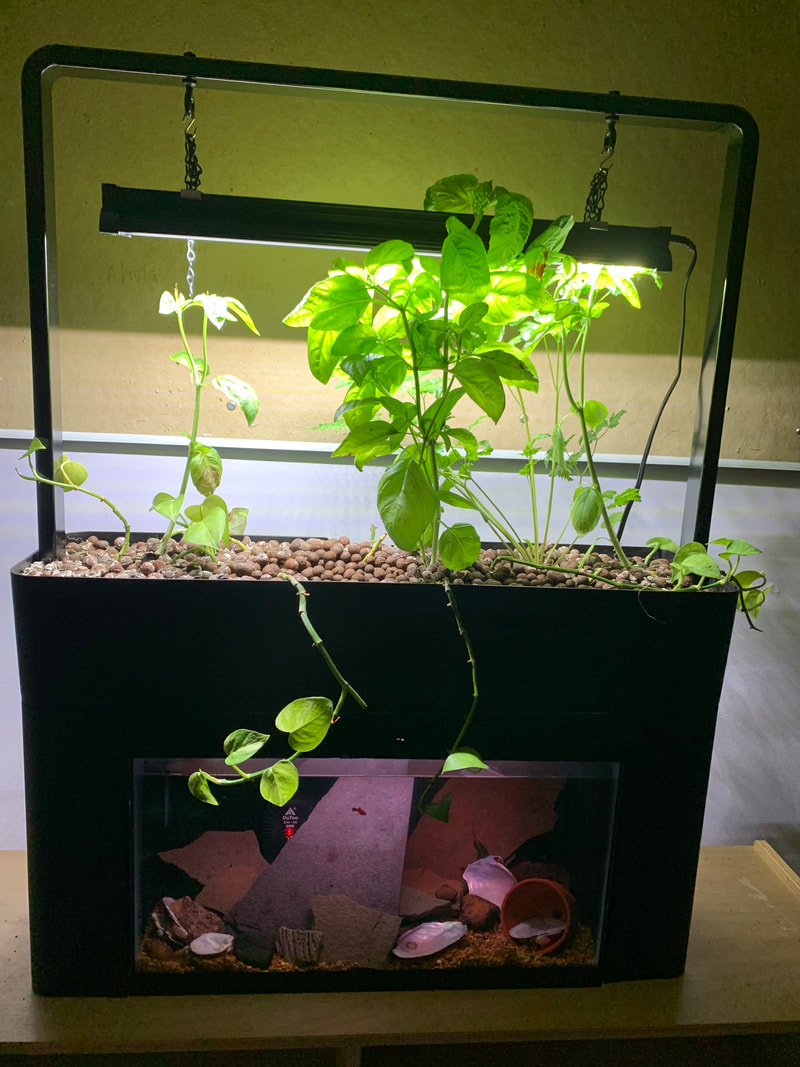

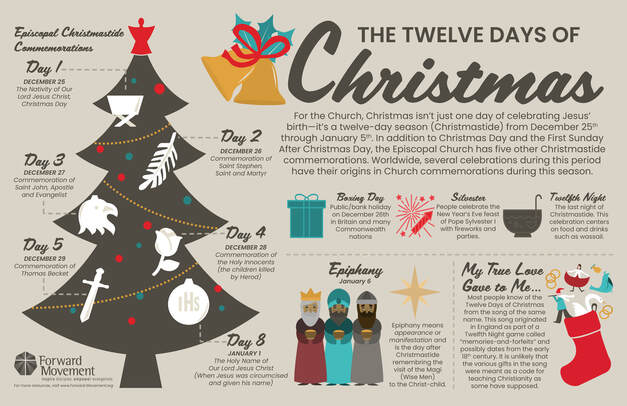
 RSS Feed
RSS Feed